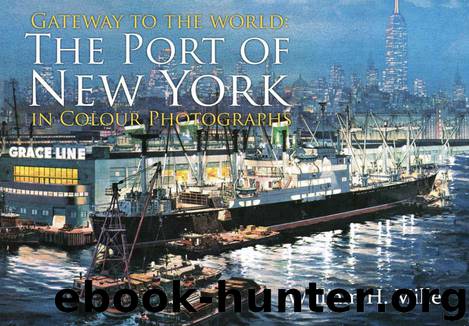Gateway to the World: The Port of New York in Colour Photographs by Miller William H

Author:Miller, William H. [Miller, William H.]
Language: eng
Format: epub
Publisher: Amberley Publishing
Published: 2015-10-13T16:00:00+00:00
The Hoboken piers were leased to the American Export Lines in the 1950s and '60s. (Port Authority of New York and New Jersey)
Holland America also ran a sizeable freighter fleet, typically well-maintained, trim vessels that more often used the adjacent Sixth Street pier. The Hoboken longshoremen, those dockers immortalised in Hollywood’s brilliant On the Waterfront (premiered in 1954), referred to them as the ‘dyk ships’ – vessels such as the Sommelsdyk and Soestdyk . The big liners, harbour legends such as the Nieuw Amsterdam and Rotterdam , were the ‘dam ships’. The Fifth Street was the longer and better fitted, and so therefore handled the liners. The adjoining Sixth Street dock was for freighters mostly, the company’s separate fleet of smart-looking, always immaculate, cargo ships, which also often carried up to twelve passengers each. They sailed the North Atlantic, to and from Northern Europe, and there were at least two sailings each week in those now distant, pre fast and efficient containership days.
Separately, the liners sailed between Hoboken, Southampton, Le Havre and Rotterdam. The freighters went to Rotterdam as well, but also to Antwerp, Bremen and Hamburg. Generally, they carried American-made manufactured goods over to Europe and returned with the likes of Dutch cheeses, Dutch tulip bulbs and Dutch beer. Holland America also carried the likes of the very first Volkswagen sent to the United States, which arrived in a wooden crate in 1949 at the Fifth Street pier on the 12,000-ton Westerdam , a passenger-cargo liner.
The glorious, twin-stacked Nieuw Amsterdam was surpassed as the Dutch flagship in September 1959 by the even larger, more luxurious, Rotterdam . But shortly after her maiden arrival (with the future queen of the Netherlands onboard as a passenger) on the Jersey side, the Rotterdam was towed across to Manhattan’s Pier 40, then in the earliest stages of construction. It was a grand publicity stunt: having the world’s newest liner berthed at the Port of New York’s newest passenger pier. Pier 40 was also New York City’s biggest marine terminal and certainly its most modern and innovative, with an inner core as well as rooftop parking, drive-alongside facilities and three instead of two riversides for berthing ships. The Holland America Line could hardly have refused the city’s offer, and so abandoned Hoboken (after some seventy years), especially as the new pier was so easily accessible to midtown Manhattan.
The official transfer to the new Manhattan terminal was made by the Statendam in March 1963. She arrived and offloaded her passengers in Hoboken, but then, having been shifted across the Lower Hudson, sailed on her next outbound voyage from the brand new Pier 40 in Greenwich Village. But even those final years in Hoboken left an indelible mark. The stillness of cold, often frigid, winter nights, for example, might be interrupted only by the 10.00 p.m. departure whistles of a Holland America liner steaming off on a cruise to, say, the sunny Caribbean. On quiet Sunday afternoons, townspeople sometimes wandered down to the dockside to watch one of the ships tie-up.
Download
This site does not store any files on its server. We only index and link to content provided by other sites. Please contact the content providers to delete copyright contents if any and email us, we'll remove relevant links or contents immediately.
Small Unmanned Fixed-wing Aircraft Design by Andrew J. Keane Andras Sobester James P. Scanlan & András Sóbester & James P. Scanlan(32155)
Navigation and Map Reading by K Andrew(4568)
Endurance: Shackleton's Incredible Voyage by Alfred Lansing(3871)
Wild Ride by Adam Lashinsky(1664)
And the Band Played On by Randy Shilts(1632)
The Box by Marc Levinson(1606)
Top 10 Prague (EYEWITNESS TOP 10 TRAVEL GUIDES) by DK(1574)
The Race for Hitler's X-Planes: Britain's 1945 Mission to Capture Secret Luftwaffe Technology by John Christopher(1534)
The One Percenter Encyclopedia by Bill Hayes(1474)
Girls Auto Clinic Glove Box Guide by Patrice Banks(1374)
Trans-Siberian Railway by Lonely Planet(1353)
Looking for a Ship by John McPhee(1328)
Batavia's Graveyard by Mike Dash(1309)
Fighting Hitler's Jets: The Extraordinary Story of the American Airmen Who Beat the Luftwaffe and Defeated Nazi Germany by Robert F. Dorr(1307)
Troubleshooting and Repair of Diesel Engines by Paul Dempsey(1291)
Bligh by Rob Mundle(1280)
TWA 800 by Jack Cashill(1258)
Ticket to Ride by Tom Chesshyre(1236)
The Great Halifax Explosion by John U. Bacon(1235)
